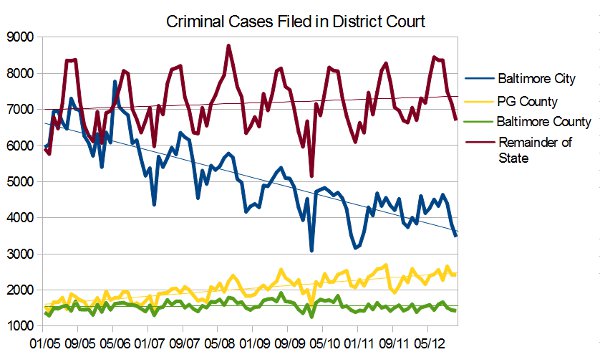In the last post I linked to a compilation I did of statistics taken from the District Court Website from 2005-2012.
While that makes for a lot of numbers, perhaps the most critical to analysis of the criminal justice system is the number of cases filed. If we had 10 cases filed a year, for example, the system we’d design and the manner in which we’d treat the cases would be significantly different than if we had 100,000 cases filed a year. Unfortunately, with over 186,000 cases filed statewide in 2012, our system is forced to handle many cases rather than few.
And that’s where the statistics come in; using numbers properly, one can pick the system apart and see where inefficiencies have developed. Lest one believe that this is merely an intellectual exercise, “playing with numbers” of no consequence, where the lives and interests of the public are at stake along with the life and interests of a defendant, a structural “inefficiency” can have terrible consequences.
And so let’s take a look at “the big picture.”

Taking the statistics at face value, it’s tempting to say that “crime” in Baltimore City is declining even as it rises throughout the rest of the state. After all, using annual numbers from 2005 to 2012 there was a 36.4% decline in cases filed in Baltimore City while the rest of the state experienced a 13.18% increase.
But measuring “crime” in such a manner ignores the fact that 2005 was “the height of the Baltimore Police Department’s experiment with zero-tolerance policing.” This meant that individuals committing “quality of life” crimes such as disorderly conduct, loitering, and the like were arrested with considerably greater frequency than the present. With the shift from zero-tolerance policing, the number of criminal cases filed has declined significantly. This does not necessarily mean that “crime” has declined, however, as a reduction in quality of life crimes may have masked an increase in other crimes.
What is certain, however, is that the nearly 40% decline in cases from 2005 should have had a profound impact on the criminal justice system in Baltimore City, particularly the District Court (the court having jurisdiction over these “quality of life” criminal cases).
In the next posting, I’ll take a look at trends that may contradict that assumption.
Maryland Criminal Law and Policy
A Resource for Practitioners within Maryland's Criminal Justice System
